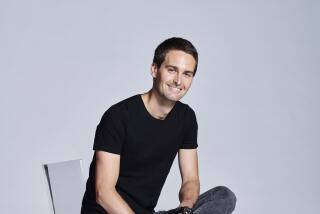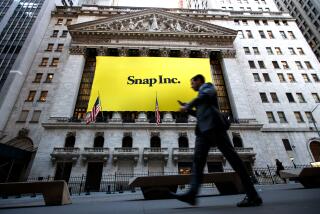PepsiCo’s ‘90s Challenge, and Why Gap Wears Well
- Share via
Stock Exchange gives readers a chance to listen in as staff writers James Peltz and Michael Hiltzik debate the merits of individual stocks.
PepsiCo Inc. (PEP)
Mike: Our two companies today offer stark lessons in what a brand name can and cannot do for you. I’m afraid PepsiCo has learned the hard way that a famous brand alone does not guarantee success.
Jim: Let me translate: They blew it. A decade ago, PepsiCo was the toast of Madison Avenue for its aggressive, savvy marketing, which nearly brought Pepsi even with archrival Coca-Cola in the U.S. soda pop market.
Mike: Didn’t PepsiCo CEO Roger Enrico even write a book called “The Other Guy Blinked” and subtitle it “How Pepsi Won the Cola Wars”?
Jim: Ah, the cola wars. That phrase was spawned by PepsiCo’s famous taste tests, like the “Pepsi Challenge.” In fact, PepsiCo’s marketing at one point was so effective that it led Coca-Cola to tinker with its secret formula.
Mike: Which gave us the world-beating blunder named New Coke.
Jim: One of corporate America’s most famous duds. But that was then. In the ‘90s, PepsiCo has been the one with real problems, and Coca-Cola comfortably remains the world’s best-selling soft drink.
Mike: Which guy is blinking now?
Jim: Exactly. Here’s the story: PepsiCo not only makes Pepsi, Mountain Dew and some other sodas, it also owns giant snack maker Frito-Lay, whose goodies include Fritos, Doritos, Ruffles, Lay’s, Cheetos and others.
Mike: Staple foods around my house. Pepsi also recently shelled out $3 billion to buy the Tropicana orange juice business.
Jim: Right, and Enrico’s been shedding other units to keep his eye squarely on drinks and snacks. Last year he dumped Taco Bell, Kentucky Fried Chicken and Pizza Hut, spinning them off into a new company called Tricon Global Restaurants. I hate to digress, Mike, but what corporate genius came up with that name?
Mike: Sounds like the evil conglomerate in a Mel Brooks movie.
Jim: Anyway, Enrico indeed is trying to pump up PepsiCo’s investment in marketing and promoting its drinks and snacks, because the company’s earnings these days just aren’t growing much. His most recent effort is a new diet cola called Pepsi One.
Mike: I just had one of those about 20 minutes ago.
Jim: And?
Mike: Frankly, it’s not that bad. And it’s a lot more like Diet Coke than Diet Pepsi is, which to my mind is a huge advance in technology.
Jim: There’s something else he’s doing--even if it’s dreadfully late. PepsiCo is now trying to place its sodas and snacks closer together in supermarkets, to spur more sales of both. Considering that PepsiCo has owned Frito-Lay for some three decades, it seems silly that we’re discussing this strategy as new.
Mike: I guess he had to hire a few rocket scientists to tell him that when you eat a snack that’s salty, the next thing you want to do is drink something wet.
Jim: Incredible. But is this stock worth owning?
Mike: In the long run, I do like this stock--but I’m skeptical over the short run. A lot is riding on PepsiCo’s marketing and new-product efforts, and those traditionally are very risky. The marketing graveyard is littered with sure things gone mysteriously awry. I mean, is one more diet cola really going to take the world by storm? This is anything but a slam dunk.
Jim: I’m with you. Pepsi’s brands still carry enormous clout and take up lots of shelf space, and I still think Enrico can get the job done. But even he said recently that PepsiCo is very much in transition right now. Until there’s clearer evidence that he’s got this company moving ahead, I see the stock--now selling in the high 30s--as treading water.
Mike: Also, restructurings come and go. Sometimes they work; sometimes they don’t. And to underline the uncertainty around this stock, PepsiCo just last week announced the long-awaited spinoff of its $7-billion bottling operation.
Jim: Something Coke did years ago.
Mike: Right. So as I see it, everybody on the Street seems to be writing off the next six to 12 months as a time when PepsiCo will be in a tryout period and not much will happen.
Jim: I want to like this stock, especially since it’s selling for about 31 times earnings--just above the market’s multiple. But there’s a reason why the stock is up only 4% for the past 12 months, versus the 20% gain in the Standard & Poor’s 500. PepsiCo’s situation, if you will, is just too fluid.
Gap Inc. (GPS)
Mike: The Gap is another brand name that’s had its ups and downs over the years, but this company, unlike PepsiCo, right now is riding high.
Jim: This is our first venture into the rag trade, Mike, which I’ve always viewed as a business that’s easy to explain--and hard to execute well.
Mike: Meaning?
Jim: Here’s their goal: Sell quality clothes that people want to wear, at a price they want to pay. But it’s extremely hard to do that.
Mike: In fact, as any Hollywood or TV executive will tell you, when you’re dealing with questions of personal taste, in the end you just don’t know nothin’.
Jim: Gap, though, seems to know somethin’ these days. The company’s sales are growing sharply, its profit margins are widening and its stock is soaring. This company is earning more than 8 cents per dollar of sales--an excellent margin for an apparel retailer. And just last week, Gap said its third-quarter profit shot up 45% from a year earlier, topping the Street’s forecasts yet again.
Mike: What’s also interesting is that Gap does this in a way that removes some of the guesswork about what will be popular. It doesn’t sell high-fashion stuff that changes with each phase of the moon, but rather very basic stuff that’s more likely to endure.
Jim: The Gap is all about white shirts, khakis, denim and other casual clothes. Their stuff looks good, it’s well-made, comfortable to wear and doesn’t cost a fortune. See, I told you it’s a pretty simple formula!
Mike: Hardly. In fact, it wasn’t that long ago that Gap didn’t seem to have a clue about what works.
Jim: Let’s review. This company was started by a couple of hippies in San Francisco in 1969 ...
Mike: Gap was shorthand for “Generation Gap.”
Jim: ... and it started by basically selling denim jeans. By the early 1980s, though, Gap was a rather lackluster chain. Then it hired one Mickey Drexler from AnnTaylor. Drexler turned Gap into what it is today and still runs the place with an iron grip. Gap today has some 2,340 stores, which include Gap, GapKids, Banana Republic and Gap’s latest creation, Old Navy Clothing Co., a chain that’s been very successful.
Mike: Despite Old Navy’s obnoxious television ads. But even Drexler has had his rough patches.
Jim: Right. Banana Republic is one. It started in the mid-’80s by selling hunting jackets and jungle wear, which went out of style, oh, immediately.
Mike: I remember telling friends that I was one of the few people who had a right to buy clothes at Banana Republic, because I actually lived in a banana republic! I would buy those safari clothes and actually wear them on safari out of my posting in Nairobi, where they fit right in.
Jim: Moving right along, Drexler turned that operation around, and in the ‘90s he transformed Gap into a huge brand name. You can credit styles that complemented the growth of “casual Fridays” in the office, those clever Gap ads that showed past and present celebrities who wore or wear khakis, Gap-designed styles that were appealing, and a flood of new stores that made Gap more of a household brand.
Mike: Even Gap’s had to correct itself in the ‘90s, though. Only a couple of years ago, Gap got a reputation for shabby stores and less-than-wonderful sales help. Drexler addressed those issues in a hurry.
Jim: And there was the debut of Old Navy, which focuses on less-expensive clothing for the family. It’s been a knockout.
Mike: But what do you think of the stock?
Jim: There’re lots of reasons to pass on this stock. Now selling in the high 60s, it’s nearly doubled in price over the last 12 months, and it’s quintupled over the last five years. It currently sells for a rich 35 times ’98 earnings. But I’d be a buyer anyway. I like the momentum of both the company and the stock, especially now that Gap is widely viewed as the premier apparel retailer in the country.
Mike: I like this stock too. It’s true that Gap stores are becoming ubiquitous. You can find them in almost every mall. But wherever you visit a Gap, you can basically count on finding quality clothes at a reasonable price that won’t quickly go out of style.
Jim: And the public knows that. Get this: Last month, Gap’s sales in stores that have been open at least a year shot up 18%! That’s breathtaking for the rag trade.
Mike: Not only that, it was nearly twice what Wall Street was expecting. And I think the signs are that Gap will continue to deliver good numbers.
Jim: Another kicker: Gap recently announced a 3-for-2 split for later this month, and it plans to buy back up to 30 million of its shares. But there is one remaining potential pothole.
Mike: Gap’s reliance on Mickey Drexler?
Jim: You got it. This guy is legendary for controlling every facet of Gap. One has to remember that if you own this stock, you’re betting that Drexler will stick around and keep getting it right. Even for Drexler, that’s a tough challenge, given how quickly consumers’ fashion tastes can change.
Do you have a stock you would like to see discussed in this column? Michael Hiltzik can be reached at michael.hiltzik@latimes.com; James Peltz can be reached at james.peltz@latimes.com. Or write to either at Business Section, Los Angeles Times, Times Mirror Square, Los Angeles, CA 90053.
(BEGIN TEXT OF INFOBOX / INFOGRAPHIC)
PepsiCo
Monday: $38.00
Gap
Monday: $68.44
More to Read
Inside the business of entertainment
The Wide Shot brings you news, analysis and insights on everything from streaming wars to production — and what it all means for the future.
You may occasionally receive promotional content from the Los Angeles Times.











